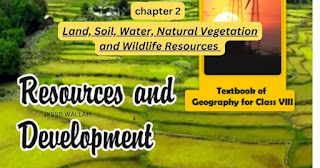Land, Soil, Water, Natural Vegetation
and Wildlife Resources
1. Answer the following questions.
(i) Which are the two main climatic factors responsible for soil formation?
Ans: Temperature and rainfall are the main climatic factors that contribute to soil formation. Rainfall affects weathering and the creation of humus in the soil.
(ii) Write any two reasons for land degradation today.
Ans: Overuse of chemicals and deforestation cause land degradation. Growing population and demand lead to forest and arable land loss, threatening this valuable resource.
(iii) Why is land considered an important resource?
Ans: Land is a significant resource with versatile applications such as agriculture, forestry, mining, construction, roads, and industrial setups.
(iv) Name any two steps that the government has taken to conserve plants and animals.
Ans: The government takes two major steps to protect and conserve plants, animals, and natural vegetation:
1. Establishing national parks, wildlife sanctuaries, and biosphere reserves to safeguard natural vegetation and wildlife.
2. Conducting awareness programs like social forestry and tree plantation, such as ‘Vanamahotsava,’ to conserve forests as a valuable natural resource.
(v) Suggest three ways to conserve water.
Ans: Three main ways to conserve water are:
- Planting more trees and increasing vegetation to slow down surface runoff.
- Adopting rainwater harvesting techniques to replenish underground water.
- Minimizing water loss in irrigation and transitioning to less water-intensive agricultural practices
2. Tick the correct answer.
(i) Which one of the following is NOT a factor of soil formation?
(a) Time
(b) Soil texture
(c) Organic matter
(ii) Which one of the following methods is most appropriate to check soil erosion on steep slopes?
(a) Shelterbelts
(b) Mulching
(c) Terrace cultivation
(iii) Which one of the following is NOT in favour of the conservation of nature?
(a) switch off the bulb when not in use
(b) close the tap immediately after using
(c) dispose poly packs after shopping
3. Match the following.
| Land use | prevent soil erosion |
| Humus | narrow zone of contact between the lithosphere, hydrosphere and atmosphere |
| Rock Dams | productive use of land |
| Biosphere | organic matter deposited on top soil |
| contour ploughing |
Answer :
| Land use | productive use of land |
| Humus | organic matter deposited on top soil |
| Rock Dams | prevent soil erosion |
| Biosphere | narrow zone of contact between the lithosphere, hydrosphere and atmosphere |
4: State whether the given statement is true or false. If true, give the reasons.
(i). Ganga–Brahmaputra plain of India is an overpopulated region.
Ans: True
(ii) Water availability per person in India is declining.
Ans: True
(iii) Rows of trees planted in the coastal areas to check the wind movement are called intercropping.
Ans: False
(iv). Human interference and changes of climate can maintain the ecosystem.
Ans: False

